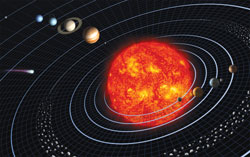 The last days of 2006 saw the blasting off into space of a telescope to probe for extra-terrestrial life. 2007 marks half-a-century of space exploration, an event astronomers around the world will celebrate as International Helio-physical Year (IHY). The term 'helio-physical' is an extension of 'geophysical', and denotes that the Earth, Sun, and Solar System are to be studied not as separate domains but as universal processes governing the human realm of space. The world scientific community has planned an international program of scientific collaboration, and other activities (www.ihy2007.org).
The last days of 2006 saw the blasting off into space of a telescope to probe for extra-terrestrial life. 2007 marks half-a-century of space exploration, an event astronomers around the world will celebrate as International Helio-physical Year (IHY). The term 'helio-physical' is an extension of 'geophysical', and denotes that the Earth, Sun, and Solar System are to be studied not as separate domains but as universal processes governing the human realm of space. The world scientific community has planned an international program of scientific collaboration, and other activities (www.ihy2007.org).
Astronomers in the USA recently decided to establish a private voluntary organisation called Astronomers Without Borders, to use astronomy as an international language through which people of different nations and cultures can come together, thus fostering goodwill, understanding and peace.
NASA has planned an eventful 2007. In addition to its usual shuttle programme, in June, the agency will also launch the Dawn mission, the first spacecraft to orbit two planetary bodies (Ceres and Vesta) on a single voyage, the Phoenix mission in August to uncover clues in Mars's arctic soil about the history of water on the red planet, and the Glast mission in October to study energetic objects and phenomena in the universe.
Closer home, there is brilliant news from Gaighat, Udayapur. The Kosmandu Astronomical Society has started organising planetary observations for schoolchildren using a small telescope provided by the Permission to Dream program. The society has also started publishing a free electronic newsletter The Astral Journal (TAJ). For more information, visit www.kosmandu.org.
In 2007, Nepalis will get a chance to observe a Solar eclipse and two Lunar eclipses. On 19 March, a partial solar eclipse will be visible, in which the disc of the Sun will be half covered by the Moon's shadow. Total Lunar eclipses will be seen on 4 March and 28 August.
Comet-watchers will be pleased to know that there are two comets passing close by this coming year, Encke on 17 May, and NEAT on 14 July.
Highlights in January include:
. The Sun is in the constellation of Sagittarius at the start of January, moving into Capricorn on 20 January. The Earth is at perihelion (its closest point to the Sun) on 3 January at a distance of 0.983 AU. It's always surprising to realise that our world is closest to the Sun in mid-winter.
. Mercury is in superior conjunction (behind the Sun) on 7 January, but by the end of the month, expect to see this planet low in the west, just after the Sun sets.
. Venus starts the year as a brilliant Evening Star, low in the west at sunset, and setting a couple of hours after the Sun. At the end of January, Mercury and Venus will be fairly close.
. Mars rises in the south-east an hour or two before the Sun. Try looking for it low in the east at dawn, just below bright Jupiter.
. Jupiter rises about three hours before the Sun, and is well up in the east at dawn. Day by day it is moving slowly south-eastwards against the stars of Ophiuchus.
. Saturn, in Leo, rises early in the evening, shortly before 8pm at the start of January and every night draws closer to Regulus, the brightest star in Leo.
. Meteor showers: The Quadrantid meteor shower should produce a good display on 3 January, and you could hope to see one Quadrantid every minute or two. The radiant point is between the bright star Vega (Abhijit) and the 'handle' of the Plough (Saptarshi).


